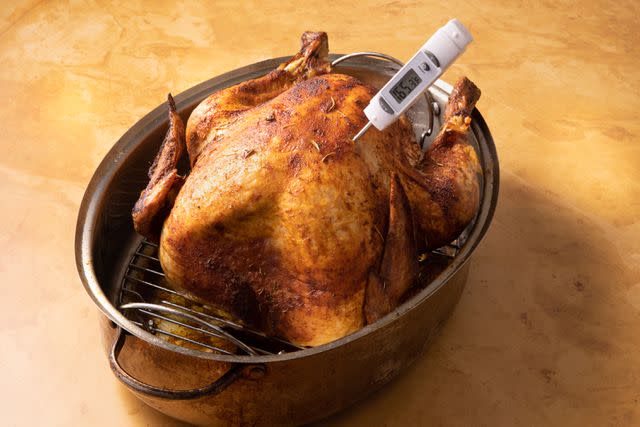At What Temp is Turkey Done and Safe to Eat? Here's What to Know
Serving up a perfect holiday bird is as easy as knowing at what internal temperature the turkey is done.
Whether it's your first year in charge of roasting the turkey for Thanksgiving or you want to know how to avoid overcooking, you'll want to know at what temp turkey is done. Knowing the proper internal temperature of cooked turkey is critical to ensuring the main course doesn't turn out super-dry from too long a stay in the oven or undercooked (and unsafe to eat).
Follow our method to feel confident you're cooking your turkey correctly. We'll provide the details for accurately reading the internal temperature, including where on the bird to check. Rest assured, you'll know when your roasted turkey is safe and ready to carve at the holiday table.
Related: How to Cook Turkey in an Electric Roaster to Free Up Oven Space

BHG / Crystal Hughes
Download Our Free Poultry Roasting Chart
At What Temp Is Turkey Done?
Regardless of the size of your turkey, it's safe to eat once its internal temperature reaches 165°F, which you can gauge using a meat thermometer. When roasting turkey, here are the temperatures to follow:
Whole turkey: On your meat thermometer, a whole cooked turkey should reach an internal temperature of 165°F in the breast and 175°F in the thigh.
Whole turkey, stuffed: The center of the stuffing must reach 165°F.
Turkey breast, boneless: The thickest portion of the breast should reach 165°F.
Turkey breast, bone-in: The thickest portion of the breast should register 170°F.
Related: We Put 21 of the Best Meat Thermometers of 2023 to the Test, and These 7 Were Our Favorites
Where to Check Turkey Temperature
Checking the turkey's internal temp in the right spot is essential for a safe meal. You can use an oven-going thermometer by inserting it into the center of an inside thigh muscle, being careful not to touch the bone. If you use an instant-read thermometer, insert it, as well, into the center of the inside thigh muscle, checking the temperature in several places.
Timing is important when roasting a turkey. Use our guide for how long to roast turkey so that the timing matches the size of your bird. If it's frozen, don't forget to thaw your turkey in plenty of time before being roasted for the feast. If you're unsure where to start when it comes to choosing a turkey, use this in-depth guide to learn how to navigate all the grocery store labels with ease.
Our Holiday Roasting Guide for Turkey, Chicken, Beef, and Pork
What to Do with Turkey Leftovers
You can do a lot more than just make turkey sandwiches with your leftovers once the meal is over.
Make a rich and delicious turkey broth once you remove the meat from the carcass.
Cook up Vietnamese Pho for a warm and flavorful soup to warm up on a wintry day.
Say olé with Mexican-inspired Turkey Mole Enchiladas for something sweetly spicy.
For lighter fare, save some bacon from your Sunday Thanksgiving weekend brunch and add crunch to a Turkey Bacon Salad.
If you want to freeze some of the leftover turkey, place it in a freezer bag and seal tightly. For extra moisture and flavor, add a little gravy to the bag. It can stay frozen for three to four months.
For more Better Homes & Gardens news, make sure to sign up for our newsletter!
Read the original article on Better Homes & Gardens.

